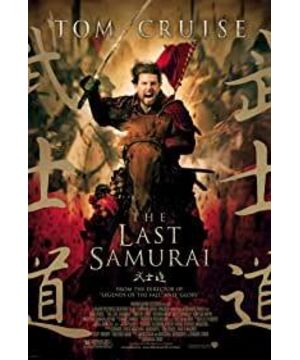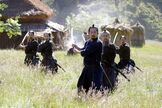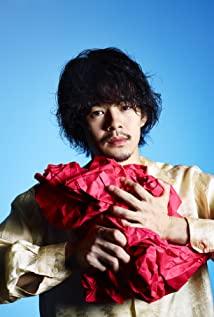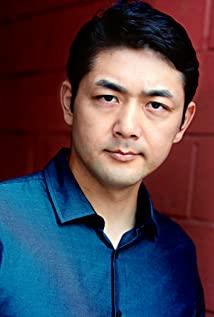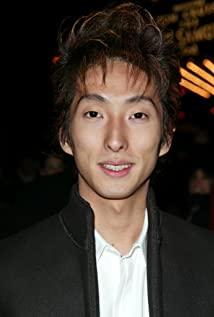11/21/2005 Let
's talk about an old movie: The Last Samurai, led by Lao Tangtang.
It tells the story of the last counterattack of the samurai class during the Meiji Restoration in Japan, but the characters in the film are all fictional except for the emperor, and the background of the times is all fictional except for the Meiji Restoration, and the plot of the old class samurai fighting against the times may exist, but still Exaggerated, this plausible description is called an alternate history.
Katsumoto's perseverance and tragic remind people to think of China's old and young, the so-called diehards during the Westernization Movement. Trying to salvage, has become a moth to the flames of the countercurrent throughout the era. I thought I was deeply hurt, because I played a historical role that was destined to be eliminated, so I was destined to find no excuses to justify myself and an exit to escape.
Katsumoto's perseverance is still going on. Hollywood films are sometimes like the Spring Festival Gala, and they never forget the sanctimonious and the bad. I don't know if this is another meaningful reprimand for those who insist on localization and nationalism to give up their weapons and primitive violence, and obediently tame pan-Americanism under the guise of globalization.
History students will inevitably have a perverted mentality of being critical when they look at things that make up history.
A film critic who has a better understanding of Japanese military history said this:
The film puts too much emphasis on the disparity between the samurai sword and guns, as if the samurai in the early Meiji period were all antiques. In fact, the Japanese samurai was the first army in Asia to fight with a large number of practical guns. They knew about the benefits of Western muskets four hundred years ago. Oda Nobunaga is the elite of the Takeda Army who used the musket team to annihilate the Furin volcano. The number of guns in Japan during the Warring States Period is said to be the largest in the world at that time. Because the Japanese not only imported guns, but also made their own muskets after a few years of research and development. Like the scene in this film, where the armed forces of the Warring States period rushed to the musket formation, it is not like the Meiji era, but like the battle of the long strip that was destroyed by the Takeda army. Of course, there were many samurai warriors who were still resisting guns in the late period of the Tokugawa period, such as the samurai of the "Hidden Sword Demon Claw" in the Kazaka Domain, but Japan as a whole has long accepted hot weapons such as guns.
There are also many very western things. For example, they always think that "face saint" is as simple and convenient as going to church, and they can go there whenever they want.
Many relationships in the shogunate’s rule were also simplified and abstracted: after the end of the Tokugawa shogunate’s rule and the emperor’s pro-government period, the Japanese government included the prime minister and various ministers in the cabinet in addition to the emperor. These ministers have no role in the play. In the play, there is only one villain minister, Omura, who went to the United States, bought arms, opened railways, and brought troops. What kind of high-ranking official should he be? Minister of Foreign Affairs, Minister of Transport and General of the Army? Dare to love is Japan's Li Hongzhang.
Katsumoto's identity is also strange, Teacher Emperor? The position of the Emperor Teacher feels like a faction of the imperial ministers in the capital. It is unlikely that a local prince or a feudal lord will go to the Emperor Teacher. In particular, Rongho Matsudaira, the lord of the Aizu domain at the end of the Tokugawa period, was dispatched by the shogunate to Kyoto to serve as the guardian of Kyoto. The feudal lord is considered a subordinate of the shogun, and the feudal lord is usually not so familiar with the emperor. If Katsumoto was not the feudal lord, it was unlikely that he could muster an army to fight for him.
If you want to describe the samurai, it is not enough to just write about Bushido. The essence is naturally important, but to do scholarship, you still need some flesh and blood.
The decline of the samurai class was one of the main backgrounds of the Meiji Restoration, and the samurai of the middle and lower classes were the main force in the fallout movement.
The Heian-kyo period was the era when samurai were born. As a symbol of violence, samurai did not have their own spiritual connotation at the beginning. The robbery of murder and robbing was despised by the later samurai, but it was the means of earning a living for the early samurai.
In the Tokugawa shogunate period, in order to control the samurai, a land-centered feudal system was implemented, and the land of the whole country was assigned to samurai, and the full authority to rule the feudal state was granted. The lords of these territories are "Daimyo", with an income of more than 10,000 shi. Below the daimyo, there are middle- and lower-level warriors with less than 10,000 shi of Lumi, called "Qiben", with about 5,200 people; , both directly belonged to the general's samurai. There are also a large number of retainers and lower-level samurai under the daimyo.
The so-called "royal family" system means that the samurai and the shogunate formed a master-slave relationship. The shogunate recognized that the samurai class had hereditary ownership of the land. During the Tokugawa shogunate period, the shogun concentrated the ownership of land in the hands of the shogun alone, and absolutely prohibited private ownership of land, "not letting all the power in the world belong to the samurai". From the combination of the samurai and the land, it has evolved into the combination of the samurai and the rice in the lord's warehouse, and even the ancestral land ownership has become the rice in the lord's warehouse - Lumi (also called salary). The economic lifeline of the samurai was in the hands of the merchants and the lord, and they completely lost their economic independence. The samurai had to exchange loyalty for material means of subsistence, in exchange for the samurai status and status of future generations.
"Bushido" originated in the Kamakura shogunate era. It was the samurai's moral code formulated by the shogunate, which made this huge system superior and inferior, with strict hierarchies and clear positions. In order to consolidate the hierarchical system and order and strengthen the combat effectiveness, the samurai group constantly came up with some "family rules" and "family laws" to discipline the samurai. This is the origin of Bushido.
It is worth noting that the master-slave relationship in the Tokugawa period was strongly unequal, which blindly emphasized the rights of the master and the obligations of the vassals, which were unilaterally prescribed by the superiors and ignored the wishes of the vassals. All retainers and warriors have no right to cancel their affiliation with the lord, let alone resist the lord. The Wu family society is headed by "loyalty", and the retainers can only be loyal to one lord from generation to generation. In 1632, "The Laws of the Scholars" clearly stipulated that "those who give up serving the public shall not be accepted." The retainers and warriors are separated from the destiny of the lord, and they are called ronin and lose Lumi. Third, the vassal can arbitrarily find an excuse to deprive the vassal of the right to take the land.
This strong inequality and the samurai's economic independence can actually be a great hidden danger in times of social instability. The samurai class itself is a competitive class, and has always used force to speak for itself, and they are always present in military operations or political disputes. So the Tokugawa shogunate's strict control of the samurai class was actually planting a ticking time bomb for its own domain.
During the first two centuries of shogunate rule, social conflicts were relatively peaceful, and the samurai class lived in peace. But in the days of peace, the warrior spirit of the samurai disappeared, and they became a parasitic class. At the end of the Tokugawa shogunate, their Lumi was reduced again and again by the precarious daimyo. In the past, a mid-level samurai could expect to earn about 100 shi and live the life of a rich peasant. The lower level in the samurai is only about 35 shi, which is almost the same as the average peasant. At that time, the vassals and retainers were no longer given full lures, and the warriors hated their masters as enmity. Coupled with the invasion of foreign forces at the end of the Tokugawa period, Japan's society was turbulent, and the new culture and new economic form caused a huge division of the samurai class.
After the middle of the 18th century, it was an eventful time for Japan. With the arrival of Western capitalist countries, Japan was forcibly opened, bringing with it the economic model of capitalism and the idea of democratic politics.
After the 17th century, the rise of urban townspeople and the development of the commodity currency economy led to the weakening of the economic power of the daimyo and samurai, and the extreme impoverishment of lower-level samurai, causing their privileged status to be shaken. Some of them have a tendency to become bourgeois again, and some of them have become political spokespersons for social change because of their exposure to Western culture. In short, a group of people was born from the lower-level samurai and became the main force of the reform revolution. As a result of the bankruptcy of the samurai class, some became ronin, and some engaged in manual labor, such as lacquer, paper, rope, lantern and other industries; some served as small government officials, and the lower-level police officers and policemen in Japan were all samurai; Merchants, professional soldiers, farmers, workers, doctors, teachers, monks, etc., made the samurai penetrate into every cell of society. The samurai even became the adopted son of the merchant. "Anyone who adopts a child will be given the status of a nominal samurai. Those who receive 100 shi of rice a year will receive 50 taels of gold, and those who are urgently adopted will receive 70 taels to 100 cars." This part of the lower-level samurai and merchants and capitalists combined, the yen and the Combining the swords, Ogawa Xiandao pointed out: "In the law, the samurai governs the people and the merchants govern the people. In fact, today is an era when the townspeople are in charge."
The roots of the Bushido spirit have also changed in thought.
In Japan's original Chinese studies based on the concept of practice and practice, Yangming studies occupied a large part. Yang Mingxue is a philosophy representing the lower warriors and the bourgeoisie. Japanese Yangming scholars are either inferior samurai themselves, or born in inferior samurai. This naturally determines that the moral orientation of Japanese Yangming School is to become a samurai. The status of the samurai in Japan can be imagined, it is a symbol of glory.
During the Restoration Period, it became a catalyst for the disintegration of the feudal shogunate, especially at the end of the Tokugawa period, Yang Mingxue played a leading role in Japan's Meiji Restoration by subverting the feudal shogunate. Yoshida Songyin was not afraid of imprisonment and beheading, and he fought for the reform of the monarchy all his life. The effect was a powerful blow to the vassal system; the founding fathers of the Meiji period, Ito Hirobumi and Saigo Takamori directly advocated civil rights, democracy, and the abolition of fiefdoms and the establishment of prefectures, realizing capital for Japan. ideology laid the foundation. In a word, from the viewpoint of efficacy, the Japanese Yangming School promoted the development of Japan's recent modernization through the disintegration of the Japanese feudal system.
In the last years of the Tokugawa shogunate, the lower-level samurai reformers who initiated and led the Rejuvenation Movement were not only the retainers of the traditional samurai concept, but also the enlightened reformists who were good at accepting the new things of Western capitalism. They accepted modern Western ideas from the only open mouth of Japan, "Nagasaki", which was closed to the country, and developed Sinology into a very new Japanese culture - "Lanology". The representative figures Sakuma Xiangshan, Yokoi Konan and Yoshida Shoin, as well as their disciples, are all like this. They began to turn their attention to politics, economics, and society, and Lan Xue gradually developed into a Western Xue corresponding to Chinese Xue.
In 1854, Sakuma Xiangshan wrote a famous line in "Records of the Provinces and Guilts" in prison: "Oriental morality, Western art, refined and crude, both inside and outside." He believed that combining Oriental morality with Western art, Taking the former as the main body and making good use of the latter can make the country prosperous and strong and resist the invasion of Western powers. Most of these scholars became active social activists, and then entered the Restoration government through various channels.
Whether it is the lower-level samurai combined with the capitalists or the blue-scientists from some lower-level samurai, because of their advanced nature and the political demands of the lower-level samurai they bear, they have become the main leading force in the fallout movement. This differentiation is a product of this special era. It is different from the traditional Japanese samurai differentiation, incorporating many world-wide elements, and its role is also of epochal significance. The overthrow of the Tokugawa shogunate and the establishment of the Restoration government opened the first chapter of modern Japanese history.
This is the real history, the demise of the last samurai, but not in the form of a slaughter battle, but a self-elimination and renewal.
View more about The Last Samurai reviews


